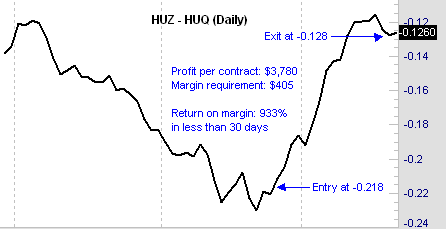A spread is defined as the sale of one or more futures contracts and the purchase of one or more offsetting futures contracts. A spread tracks the difference between the price of whatever it is you are long and whatever it is you are short. Therefore the risk changes from that of price fluctuation to that of the difference between the two sides of the spread.
The spreader is a trader who positions himself between the speculator and the hedger. Rather than take the risk of excessive price fluctuation, he assumes the risk in the difference between two different trading months of the same futures, the difference between two related futures contracts in different markets, between an equity and an index, or between two equities.
For example, a spreader might take the risk of the difference in price between August Soymeal and December Soymeal (see picture below), or the difference in price between December Kansas City wheat and December Chicago wheat, or between the strongest stock in a sector and the weakest stock in that sector.
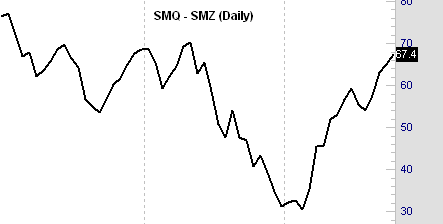
Example: Long August Soy Meal (SMQ)
and Short December Soy Meal (SMZ)
A spread trader can just as easily trade the difference between MICROSOFT and IBM (see below). Or he can trade the difference between two Exchange Traded Funds.
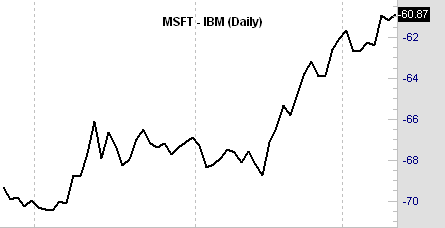
Example: Long Microsoft (MSFT)
and Short IBM (IBM)
For more spread trading examples and opportunities, and ways to trade them, scroll up to sign up for our Free Weekly Chart Scan Trading Newsletter. Emailed to you EVERY Friday!
Basically, there are 3 different kinds of spreads:
Intramarket Spreads
Officially, Intramarket spreads are created only as calendar spreads. You are long and short futures in the same market, but in different months. An example of an Intramarket spread is that you are Long July Corn and simultaneously Short December Corn.
Intermarket Spreads
An Intermarket spread can be accomplished by going long futures in one market, and short futures of the same month in another market. For example: Short May Wheat and Long May Soybeans.Intermarket spreads can become calendar spreads by using long and short futures in different markets and in different months.
Inter-Exchange Spreads
A less commonly known method of creating spreads is via the use of contracts in similar markets, but on different exchanges. These spreads can be calendar spreads using different months, or they can be spreads in which the same month is used. Although the markets are similar, because the contracts occur on different exchanges they are able to be spread. An example of an Inter-exchange calendar spread would be simultaneously Long July Chicago Board of Trade (CBOT) Wheat, and Short an equal amount of May Kansas City Board of Trade (KCBOT) Wheat. An example of using the same month might be Long December CBOT Wheat and Short December KCBOT Wheat.
Discover the incredible potential of futures spread trading and learn more about its advantages
Spreads have low time requirements
You don't have to watch a spread all day long. You do not need real-time data. These great advantages make spread trading the perfect trading instrument for professional traders and beginners.
The most effective way to trade spreads is using end-of-day data. Therefore, spread trading is the best way to trade profitably even if you do not want to watch or cannot watch your computer all day long (i.e. because you have a daytime job).
Even those who daytrade use these advantages to optimize their trading results at the end of their trading day.
Spreads are easier to trade
Take a look at the Unleaded Gas Spread again (see below).
Do you see how nicely this spread starts trending in the last week of May? Whether you are a beginner or an experienced trader, whether you use chart formations or indicators, the existence of a trend is obvious. Spreads tend to trend much more dramatically than outright futures contracts. They trend without the interference and noise caused by computerized trading, scalpers, and market movers.
Spreads have lower margin requirements
Spreads have reduced margin requirements, which means that you can afford to put on more positions. While the margin on an outright futures position in Unleaded Gas is $4,750, a spread trade in Unleaded Gas requires only $405 - 10% as much. That's a great advantage for traders with a small account. With a $10,000 trading account you can easily enter 4-5 spreads, instead of only 1 outright Unleaded Gas futures trade.
Spreads give a higher return on margin
Each tick in the spread carries the same value ($4.20) as each tick in the outright futures ($4.20). That means that on a 100 tick favorable move in unleaded gas futures or a 100 tick favorable move in the spread, you would earn $420. However, the difference in return on margin is extraordinary:
Unleaded gas futures - $420/$4,750 = 9% return on margin
Unleaded gas spread - $420/$405 = 104% return on margin (!!!)
And keep in mind that you can trade 10 times as many spread contracts as you can outright futures contracts. In our example you would achieve a 115 times higher return on your margin.
Spreads give countless trading opportunities
Spreading has gone much further than its original intent. You can spread one commodity against another (e.g. SMQ-SMZ). You can spread one stock against another (e.g. MSFT vs. IBM). You can spread one index against another (e.g. Dow Jones vs. Nasdaq). You can spread the strongest share in a sector against the sector index. There are dozens of trading opportunities each day, and you can choose the best ones.
Spreads offer a lower risk
Spreading is one of the most conservative forms of trading. It is much safer than the trading of outright (naked) futures contracts. Obviously, the risk taken for the difference in price among related contracts is far less than the price risk taken in an outright speculation. This is because related futures will tend to move in the same direction.
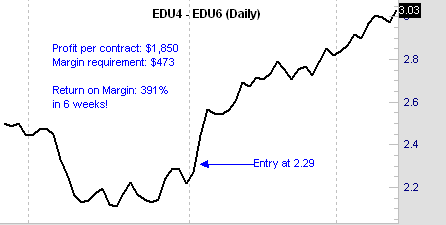
This spread was entered not only on the basis of seasonality, but also by virtue of the formation known as a Ross hook (Rh). The spread moved from -2.29 to 3.03 = $1,850 per contract. The margin required to put on this spread was only $473, thus the return on margin is more than 390%. Please note that the spread never retraced more than $225!
Spread trading does not need live data
The most effective way to trade spreads is using end-of-day or delayed data. You can save up to $600 per month in exchange fees.And you can save all the money you would have had to spend for real-time data systems (which can be up to $600 per month).
Spreads trend more often than do outright futures.
Spreads often trend when outright futures are flat. Look at the following chart: Would you want to have been long live cattle from mid-April until end of May?
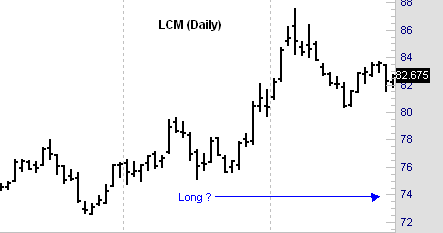
But, what about a spread between Live Cattle and Feeder Cattle?
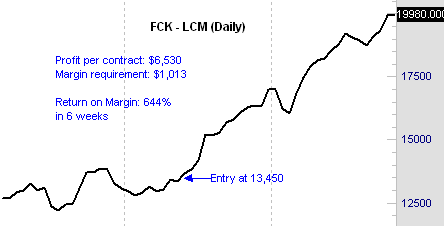
The spread moved from 13,450 to 19,980 = $6,530 per contract. The margin required to put on this spread was only $1,013. The return on margin is more than 600%.
If spread trading is so fantastic, why doesn't everyone trade spreads?
Well, it is not true that hardly anybody trades spreads - the professional traders do, every day. But either by accident or design, the whole truth of spread trading has been hidden from the public over the years.
While spreading is commonly done by the market "insiders," much effort is made to conceal this technique and all of its benefits from "outsiders," you and me. After all, why would the insiders want to give away their edge? By keeping us from knowing about spreading, they retain a distinct advantage.
The concept of trading seasonal trends and seasonal spreads has been almost entirely overlooked by the hordes of daytraders who today riffle the markets with their almost frantic noise. It is also overlooked by the fund traders. By fund traders I mean those massive pools of managed money residing in hedge funds, commodity pools, pension funds, bond funds, securities funds, etc. In fact, with the exception of the large commercial and institutional interests, the whole concept of seasonal trend and seasonal spreading has been overlooked by most traders.
So far, so good.
By now you already know more about spread trading han 95% of all traders out there. You have taken the first step by learning about the lost art of spread trading. But why is spread trading a lost art?
The reason is quite interesting: In the 1970´s and 80´s, capital gains tax laws changed and computers came into the picture, which effectively killed spread trading for the general trader. Current market conditions dictate that traders who wish to minimize their risk have to learn to trade spreads. So, if you are serious in getting started in spreads - I have good news for you!
I have decided to share my knowledge of spread trading because I realize that most current traders have never been exposed to it!
About Joe Ross:
Joe Ross, creator of the Ross hook, has over 60 years of trading experience. In 1988 he founded Trading Educators, Inc. to share his knowledge and to teach other traders to become successful. He started writing books, giving seminars and private tutoring.
To date, in addition to his own trading, he has written 12 books and personally taught thousands of traders.

"In 1997, it occurred to me that it was a good time to revive and teach the lost art and techniques of spread trading. Thus originating the manual Trading Spreads and Seasonals, which has become a classic after just a short time, and the top selling book in the field of spread trading."
Here is how to take advantage of all the benefits of spread trading to optimize YOUR trading results

This hard cover book contains more than 309 pages of practical and interesting information about spread trading. It expands on the topics mentioned above, giving you a better understanding of and insight into what spreads really are and, more importantly, how to place and manage your spread trades.
You will learn everything you need to know about Inter- and Intramarket Spreads, about Inter-Exchange Spreads, and markets suitable for spreads. You will learn how to use spreads to make money in sideways futures markets, and how to reduce and greatly eliminate the effects of volatility and uncertainty.
Here is what you will get:
Learn how to trade spreads to reduce risk
You already know that trading spreads entails less risk than does trading outright futures, but you still need concepts and techniques about how to trade them to keep the risk low.
Let me show you an easy way to hedge yourself and minimize the risk. This is also very useful for a daytrader who wants to hold a position overnight. Position trades can be held considerably longer at less risk by spreading, allowing you to participate in a big market move.
Learn all you need to know about Seasonal spread trade selection
Seasonal spreads are among the best trades possible for those who are willing to wait for these excellent opportunities to come along. They have the advantage of a very high degree of reliability over a period of many years. Trades that work 80% or more of the time are certainly worth taking. Many of these trades work 100% of the time for periods spanning 15 years or more. Yet seasonal spreads must be filtered in order to obtain the very best results. A lot of money can be lost by blindly taking these trades based upon computer-generated dates for entry and exit. You will learn how to identify the best spread for you and how to filter these seasonal spreads in order to get best results.
Specific entry and exit signals
No longer have doubts about its being the right time to enter, or even more importantly, the best time to exit a trade. I´ll show you specific signals about where to enter and when to exit a trade to achieve the best results.
Trading spreads using technical indicators
Not all traders enjoy trading only from chart patterns. You will learn how to properly use technical indicators to filter highly profitable trades.
... plus much more!
Many readers have told me that this manual is worth its weight in gold and that the information in this book, reflecting years of knowledge and experience, is worth a lot more than the money we charge for it.
However, we are holding to the same price as we have always charged, in fairness to our customers. You can still have this classic about spread trading for just $150.00.
$150.00
TRADING SPREADS AND SEASONALS BOOK
Don't take my word for it!
Here are just a few of the many testimonials I've received:
"Best book for trading Seasonal Spreads. Joe introduces filters and how to use technical indicators. This is a trading manual not a book about trading." ~ Trader from Honolulu
"I have traded futures for almost 11 years, for my own account and as a broker. I have also written three books regarding futures investing. That being said I really do know how to separate the wheat from the chaff. This book is all wheat. Joe Ross, once again, breaks the silence on spreads and seasonal trading." ~ Noble Drakoln, CA
I am impressed that you really seem to care about integrity, and helping traders to master themselves rather than the markets. You are a voice crying in the wilderness. ~ Thank you Joe."
Joe has done it again in his seventh published volume: Trading Spreads and Seasonals: a down-to-earth, easy to read common sense book for the practical commodity futures trader." ~ Bob McGovern, CA
No Risk with our money back guarantee!
Be assured you cannot make a mistake in ordering Trading Spreads and Seasonals.
We give you a 30-day money back guarantee: if you are not satisfied that this manual can help you become a successful spread trader, just send an email to my Team and return the book in salable condition. We will refund the full price of the book.
I want YOU to be one of my satisfied and successful customers!
This book will show you everything YOU need to know about:
- how to get started in spreads
- how to use spreads to make money
- how to trade spreads to reduce risk
- how to identify profitable spreads
- how to identify specific entry and exit signals
- plus much more...
$150.00
TRADING SPREADS AND SEASONALS BOOK
Dimensions: H 11 1/4" x W 8 5/8"
309 pages
30-day Money Back Guarantee*
Hardcover only
*If you aren't thrilled with Trading Spreads and Seasonals, just send it back within 30 days and we'll refund 100% of your purchase price (less s&h).
LEARN MORE ABOUT SPREADS! GO TO Spread-Trading.com BY ANDY JORDAN
Additional Info
- Time: Long Term Trading
- Market: Futures, ETFs/Stock


